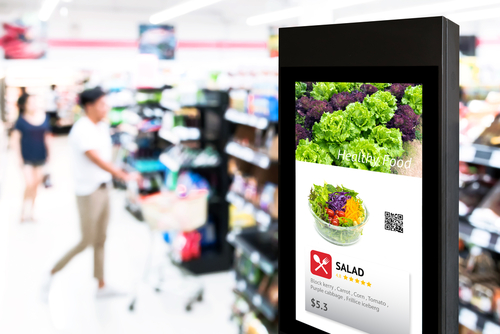Kiosks as the perfect self-service digital signage solution
By Alex Mardikian
Kiosks are being touted as the future of digital signage, and with good reason. Kiosks have come up as the ideal self-service solution for people that seek information and services. Kiosks lend themselves nicely for providing an interactive and fruitful experience for audiences in diverse settings such as healthcare, retail, and even B2B.
Kiosks have been proven to offer exceptionally high ROI over the long term because these enable businesses to do away with superfluous manpower, and because of satisfactory self-service, kiosks create sales. Flexibility in choosing the message without incurring a heavy cost, normally associated with printing, allows for bespoke messaging for an audience. Content can be altered and updated smoothly and quickly.
Consumers find it easier to reap the benefits of searchable digital information. Statistics provided offer insight into how a kiosk can be used to further business objectives. The analytics can influence everything from the price of an item searched for at the kiosk to the route of a bus that ticketholders favor. The data provided by kiosks is immensely useful and insightful.
The following uses of interactive kiosks are applicable for all industries and serve as powerful arguments for strong consideration of this tool as a medium for DOOH advertising.
1. Efficiency – A big attraction for small businesses, kiosks enable smooth self-service thereby helping with efficient working, faster throughput, shorter queues, and higher productivity.
2.Promotions – Interactive kiosks can run promotions meant for boosting customer loyalty. These can be used to disperse coupons, redeem points for gift cards and vouchers, and for spreading information. This helps cement brand loyalty.
3.Support – Kiosks that support multiple languages simplify self-service across industries. This allows businesses to reach out to clientele across diverse geographical locations
4.Security – Interactive kiosks have robust security features in place that control that manner in which personal data collection is authorized and stored. User information is protected.
5.Data gathering and analytics – Self-service kiosks are a great tool for running surveys and gathering information on how an audience feels about an existing situation or a proposed change. Analytics that includes not just the results of such surveys but also other audience interaction provides insight that guides business decisions.
6.Customer service – Kiosks can help boost customer service in a number of ways. These can serve as wayfinding systems to direct traffic or direct traffic to vacant or less crowded billing counters, or can be used for payments. Order entry at restaurants through kiosks is another way customer service can be bettered.
The choice of software is paramount in ensuring long-term working of a kiosk – interactive or functioning as digital signage. Security, interaction, integration with other systems, and the overall user experience depend on the software selected. If you seek a cheap solution that displays web content on kiosks then you can simply select Chrome, which offers a Kiosk mode or go for mKiosk by Firefox. But, these solutions are very simplistic in nature and cannot, as such, be classified as software platforms. A software solution lets you control port access, USB access, and monitor how the components are functioning. Such a software platform will also let you integrate peripheral components that enhance functionality, user experience, and data gathering capabilities. With a software system platform, you can monitor the kiosks from a remote location.
The software must be able to support a responsive touchscreen for a satisfactory user experience. Compare software system platforms for their ability to integrate with components that you deem as useful for your business. These could include bill payment, order placement, FAQ answers provider, print-on-demand software, visitor check in, and other tools and services. The platform should be able to understand the nature of faults and display appropriate messages to the user and the back-end operator.
Kiosks function in outdoor spaces and are subject to touch and use that varies in intensity. These systems need to be robust to withstand harsh use and the unavoidable exposure to the elements. Theft and vandalism are real threats and the systems must have the necessary security hardware in place to prevent such incidents. Kiosks must have tamper-resistant features that include strong welding and compression locks.
The hardware should satisfy standards such as ISO and UL. While the former is a measure for the quality of the hardware, the latter is related to safety. Outdoor kiosks must always adhere to ISO and UL (International Standards Organization and Underwriters Laboratories) standards so that your business is assured of reliable functioning by a kiosk placed outdoors.
The kiosks need appropriate sealing against dust, dirt, and water. Air-conditioning is necessary for kiosks in places where the sunlight is harsh. Sunlight also influences readability and the life of the screen.
A firm mounting is of prime importance. The kiosk must be mounted on a stable pedestal such that it is able to resist vibrations and rough use. Such mounting will minimize chances of damage to internal components.
The basic step in coming up with an interactive kiosk is the concept. The looks, functionality, and form have to coalesce to yield a working model. At the design stage, engineers need to sort out visibility and lighting issues. A CAD model must display all the screw points, welding joints, brackets and hinges, and other structural components.
After design engineering, the idea is ready for taking shape. It is ready for fabrication. This is when metal, plastic, and other materials are shaped and joined together to give shape to the kiosk. Once assembled, the kiosk is readied for software integration.
The last stage before the kiosk goes live is installation at the right location. Such locations include places where people are inclined to wait…for example in queues, and also spaces such as elevators and escalators. Store windows are a naturally good location for digital signage, these can be installed near the products being promoted.

